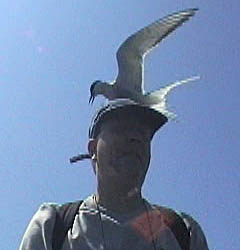 With it's wings folded the drab brown undersides and irregular margins mean it blends well with autumn leaves. Even the upper surface of the wings tends to blend with fallen leaves.
With it's wings folded the drab brown undersides and irregular margins mean it blends well with autumn leaves. Even the upper surface of the wings tends to blend with fallen leaves.
 Thanks to the BBC Wildlife magazine I now know that the reason you see it more in the autumn is down to an unusual life history. In July the first generation appears. Larger dark winged individuals are long lived and won't be sexually mature until they have hibernated overwinter. The smaller pale ones mate immediately and produce a second generation in the autumn - hence the high numbers in the 'fall'. OK it's not as complex as a large blue being brought up by ants, but it's interesting enough!
Thanks to the BBC Wildlife magazine I now know that the reason you see it more in the autumn is down to an unusual life history. In July the first generation appears. Larger dark winged individuals are long lived and won't be sexually mature until they have hibernated overwinter. The smaller pale ones mate immediately and produce a second generation in the autumn - hence the high numbers in the 'fall'. OK it's not as complex as a large blue being brought up by ants, but it's interesting enough!Whilst on the BBC subject the new website they are involved with www.loveearth.com might be worth a look. It's partly a plug for the new film Earth, but has a few interesting bits if you are into worldwide wildlife.












No comments:
Post a Comment